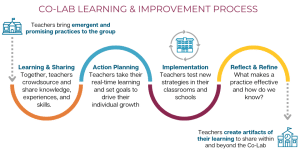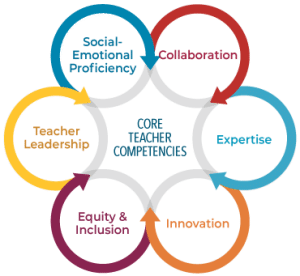Why PD Must Be Learner-Centered, Too
CompetencyWorks Blog
Despite substantial experience leading professional learning programs and even more time as a kind of Student-Centered Learning (SCL) evangelist, I have only recently begun to comprehend the extent to which teacher agency is pivotal to the success of both these things. Yet overlooking teacher agency contributes to the kinds of challenges change-makers often cite — a lack of buy-in, uneven implementation, and poor sustainability. In contrast, when teachers are given the opportunity to engage in professional development (PD) in learner-centered ways, the impact is more than simply deeper engagement: it’s also a smooth translation of theory into practice that benefits students, too.
A Learner-Centered Framework
The Teacher Collaborative’s framework for Student-Centered Learning revolves around four core principles: Authentic Experiences, Student Agency, Flexible Structures, and Assessment for Learning. While these were initially developed by our team and vetted by teachers to translate effectively into classroom practices, we have learned that they are also essential to professional learning. Teachers can — and do! — lead the work of innovation toward student-centered learning. However, learner-drivenness has to be present for teachers — in authenticity, agency, flexibility, and assessment — in order to result in truly learner-driven practices in the classroom. We learned this hands-on through our Co-Lab model.
A Model for Teacher-Driven Professional Development
A Co-Lab is The Teacher Collaborative’s signature program and our hallmark approach to professional learning, fusing the prestige of a fellowship with the camaraderie of a professional learning community (PLC), the creative emphasis of a design team, and the learning outcomes of a professional development series. Teachers voluntarily apply to our Co-Labs, and we select a diverse cohort of educators prepared to collaborate, innovate, and problem solve together. We convened Co-Labs last winter and spring focused on Student-Centered Learning knowing that we were providing teachers who were operating in “silos” the chance to work with like-minded peers.  What we didn’t realize at first was that, over time, the more that our Co-Labs were learner-centered and congruent¹ with the pedagogy they were promoting, the more effective they proved to be. When we let teachers exert their agency by driving our agendas and co-creating individual learning plans, piloting their ideas in authentic contexts, demonstrating their learning through performance tasks, and engaging flexibly with us and with each other, we saw both stronger engagement and stronger outcomes. We made mistakes along the way, of course, but we learned a few critical lessons that are now permanently part of our Co-lab design:
What we didn’t realize at first was that, over time, the more that our Co-Labs were learner-centered and congruent¹ with the pedagogy they were promoting, the more effective they proved to be. When we let teachers exert their agency by driving our agendas and co-creating individual learning plans, piloting their ideas in authentic contexts, demonstrating their learning through performance tasks, and engaging flexibly with us and with each other, we saw both stronger engagement and stronger outcomes. We made mistakes along the way, of course, but we learned a few critical lessons that are now permanently part of our Co-lab design:
- To ensure teachers have the agency to lead change work, we need to provide them both a learner-centered environment for their own development and practical resources to support their goals.
- The right resources are ones that balance usability with the space for teachers to exercise their judgment, creative energy, and agency.

- Fusing a collaborative goal — in one notable instance last year, a teacher-driven toolkit to support peer educators with SCL — with individual ones allows teachers to benefit from both individual and collective agency.
- Performance tasks that are aligned with a set of articulated competencies (in our case, six Core Teacher Competencies) provide teachers the ability to exert their agency with the support of the Co-Lab’s targets and parameters to guide them.
This Co-Lab model, which we have found to be closely aligned with Aurora Institute’s definition of competency-based education, allowed us to incubate our new SCL framework and populate that framework with the kinds of models and tools that bring concepts to life for peers. The resulting toolkit, almost entirely developed by the teachers in one Leadership Co-Lab, ultimately establishes the kind of usable tools that teachers most need in order to initiate the shift toward learner-centered practices that they might otherwise struggle to connect to their own work. Without the leadership of the teachers in the Co-Lab, it’s certain that this toolkit would have been quicker to create, but it also would have lacked the practicality and ultimate impact of something directly informed and fueled by teachers’ own classroom experiences.
Implications for Professional Learning
SCL currently exists in pockets in Massachusetts, driven largely by individual leaders’ local initiatives and hampered by ongoing policy roadblocks, like seat time requirements and high stakes tests. There are many factors outside of the locus of control of classroom teachers, which can make sustained, deep pedagogical shifts like the move to SCL feel impossible and the effort to take steps in that direction futile. However, what we have seen through several years of work with teachers has been that change is possible.
- Models like the Co-Lab support teacher confidence.
- Tools like the SCL toolkit support their ability to master the kinds of shifts that are within their locus of control — even without the support of policy or leadership.
 Even the simple act of convening teachers with like-minded peers has made a big difference, both in sentiment (more than 90% of teachers in our Co-Labs feel more connected and supported at the end than at the outset) and in impact (more than 90% of Co-Lab participants report positive impacts on their classroom practices and/or their students). Teachers who previously felt siloed now have membership in a network of support, and both Innovation in Practice SCL Toolkit and the other resources produced by our teachers as part of our Educator Exchange have created touchstones to inspire their peers in the years to come.
Even the simple act of convening teachers with like-minded peers has made a big difference, both in sentiment (more than 90% of teachers in our Co-Labs feel more connected and supported at the end than at the outset) and in impact (more than 90% of Co-Lab participants report positive impacts on their classroom practices and/or their students). Teachers who previously felt siloed now have membership in a network of support, and both Innovation in Practice SCL Toolkit and the other resources produced by our teachers as part of our Educator Exchange have created touchstones to inspire their peers in the years to come.
None of this would have been possible in a traditional PD series. Our model for professional learning had to embody our core principles of SCL in order to be truly effective:
- Authentic Experiences meant that every conversation, pilot, principle and resource was grounded in classroom-tested lessons, activities, and techniques, which resulted in a slate of tools and resources that other teachers could trust and relate to, with careful guidance to ensure they could be applied in new contexts thoughtfully.
- Similarly, Student Agency meant that teachers drove the learning agenda and had a variety of structured opportunities to build and work toward individual and group goals, resulting in a deep engagement but also ensuring that the Co-Lab benefitted from teachers’ wisdom.
- Flexible Structures meant that our Co-Labs fused synchronous and asynchronous work, used a variety of interactive online platforms and provided multiple means of interaction and support, ensuring that teachers’ engagement was not only deep but sustainable, even during the busyness of the school year.
- Assessment for Learning meant that teachers pursued mastery of one of our Teacher Competencies and created final products that demonstrated their proficiency with them, ultimately ensuring the kind of rigor required to ensure high quality outcomes.
Ultimately, we hope to see our Toolkit be an iterative resource that teachers continue to add to and revise over the course of the next few years. Our Educator Exchange is constantly evolving as teachers document new approaches and create new resources. Most importantly, our Co-Labs will always be driven by the teachers participating in it, not merely for the sake of congruence, but also by popular demand. Once teachers have experienced learner-centeredness as both learners and leaders, they rarely want to go back to “business as usual.” I feel the same way about professional learning.
¹ For more on the Congruence model for change leadership, please see the Nadler-Tushman Congruence Model of change leadership. One article to explore is Nadler, David A. and Tushman, Michael L. (1980). A model for diagnosing organizational behavior. Organizational Dynamics, Volume 9(Issue 2), pp. 35-51. https://www.sciencedirect.com/science/article/pii/009026168090039X. Although the Nadler-Tushman model, looking broadly at business organizational design, does not look at professional learning as a facet of the Congruence Model, I would hypothesize that PD’s congruence with the public, structural, and other aspects of a learning organization is as critical as any other.
Learn More
- Old Habits Die Hard: How to Build New Moves and Habits to Sustain Change
- Let Educators Drive: Gradual Release to Learner-Centered Design
- Building 21’s Teacher Competencies to Facilitate Competency-Based Learning
- A District-wide Personalized Professional Learning System to Advance Competency-Based Education
 Diana Lebeaux is Senior Director of Programs at The Teacher Collaborative, a Massachusetts non-profit organization focused on activating teachers’ potential to lead change for equity and excellence. Diana brings over a decade of experience with program development and management and is a trained facilitator. Previously, Diana was a middle school classroom teacher; directed student support and enrichment programs, and directed a team of coaches supporting equitable and inclusive school and district redesign processes. She holds a Bachelor’s Degree from Bates College in Maine and a Master’s Degree in Educational Leadership from New York University. Diana is the mom of two boys and lives with her family in the Merrimack Valley area of Massachusetts.
Diana Lebeaux is Senior Director of Programs at The Teacher Collaborative, a Massachusetts non-profit organization focused on activating teachers’ potential to lead change for equity and excellence. Diana brings over a decade of experience with program development and management and is a trained facilitator. Previously, Diana was a middle school classroom teacher; directed student support and enrichment programs, and directed a team of coaches supporting equitable and inclusive school and district redesign processes. She holds a Bachelor’s Degree from Bates College in Maine and a Master’s Degree in Educational Leadership from New York University. Diana is the mom of two boys and lives with her family in the Merrimack Valley area of Massachusetts.